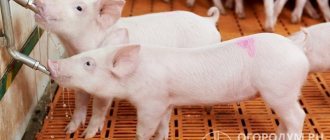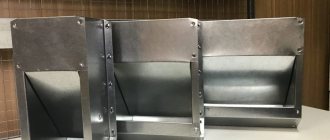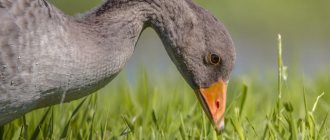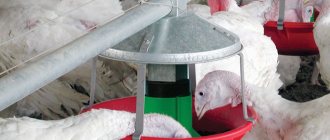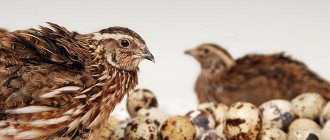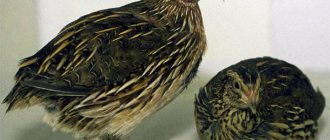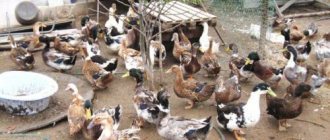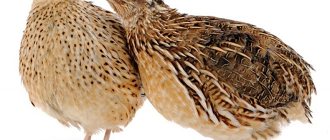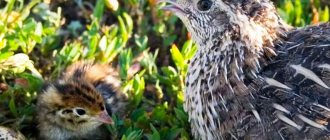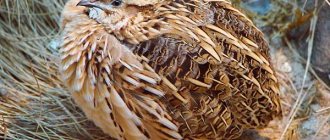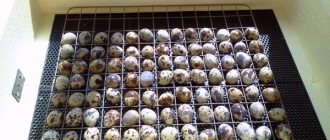In the cage with quails, it is necessary to install feeders that provide free access to food. You can not only purchase them in the store, but also make them yourself, taking into account the number of heads on the farm. To do this, you will need to select a structure of a suitable type, prepare the appropriate materials and tools, and then begin assembling the feeder according to the prepared drawings and step-by-step instructions.
"Dinnerware
We should also talk about “table” devices intended for quails.
- Firstly, the dishes need to be easy for the owner to use; the food trays must be fixed so that they can be easily removed and washed.
- Secondly, the trays are located in such a way that each individual has its own space for eating. It is recommended to provide up to eleven millimeters of space for each bird along the entire length of the tray.
- Thirdly, safety. Feeding devices must be made of safe materials and not cause harm or discomfort to birds.
Gutter feeder made of polycarbonate pipe - each individual has its own place to eat
Types of feeders and their manufacture
The choice of design for feeding chicks at each stage of their development will be different. So the first fourteen days are a tray in the brooder. Next, various groove options are used.
They are installed outside to prevent food from being thrown around. There are four types of feeders:
- Tray. One type of food is poured into a tray with small sides. Usually used for quails in the first days of life.
- Grooved. Used for feeding adult birds. They are secured only from the outside, as a result of which they have a one-sided approach.
- Bunker room. Can be mounted both inside and outside. Intended for dry food only.
- Automatic. It has a timer, which greatly simplifies the process for the quail breeder.
Bunker
Hopper feeders consist of two parts: a container for food and a tray where the food goes. Looks like a boot. It can be made from an ordinary plastic bottle or from other materials.
From a plastic bottle
A very simple option - from a plastic bottle. You need to leave about 10 centimeters from the top and drill holes for feeding food. The bottom is cut, as well as the top of the holes. Place the top part into the tray and secure with self-tapping screws. The bunker bird feeder is ready.
From chipboard
If the population is large, there may not be enough bottles. To adjust the volume, take the necessary materials (sheets of plywood and self-tapping screws) and make a hopper from a regular drywall profile, attaching the side walls to it on four sides. The width of this device corresponds to the size of the gutter, the height is calculated in accordance with the required amount of food. At the top, for attachment to the cage, you need to provide holes for the wire. The side parts are made in the form of a boot.
Grooved
This type of feeder is made of metal and plywood. A sheet with a width of 181 mm and the required length with a calculation of 50 mm per bird is marked for bending according to the pattern 50x30x50x40. The side that is adjacent to the birds’ housing is bent 10 millimeters inward to avoid rashes. After making the bends, the wooden sides are fastened to the metal with nails. All sharp elements are bent so as not to injure pets. Food of different consistencies is poured inside the feeder, since the durable design allows it to withstand the load.
Tray
Made from metal or plastic. The sheet is bent on both sides at an angle so that in cross-section the structure looks like a trapezoid. It will be stable if the base to height ratio is 2:1. A net is attached to the top to prevent young birds from scattering all the food. If the tray feeder is made of a pipe with a diameter required for stability, then a slot is made on one side, and holes are cut out at the top at a uniform frequency. Be sure to install plugs at the edges of the pipe.
Many summer residents do not have the opportunity to be there or come there often, but they still keep birds. An automatic feeder is provided for them, which is equipped with a food supply timer. They are also effective in large sparrowhawks, since they save feed by about 20%. The automatic feeder requires the manufacturer to have skills in electromechanics. The materials are the same as for the bunker, but you need to install a time relay, an electric drive, a dispenser and wires. The mechanism is simple: the timer works, the curtain opens and food comes in, then the curtain closes. The opening and closing process is done electrically. It’s easier to buy such a device, but you can make it yourself.
Types of feeders
To properly raise poultry, it is important to create optimal living conditions: keep the cage clean, provide a complete diet of food and a sufficient amount of clean water. Quails are one of those birds that leave a mess in their cage after eating.
Dirt in a bird's home, in turn, negatively affects the growth and development of pets. To cope with this situation, you need to use special bird feeders. There are several options for feeders that can be selected taking into account the type of birds, the volume of their food and water consumption.
- Tray. It is optimal to use for chicks when they reach the age of two weeks. The cage contains a tray with food, to which there is easy access. Thanks to the small sides, the chicks can easily get to food. Only one type of food is poured into such a container.
- Grooved. The most universal option, as it is suitable for birds of different ages and species. You can pour a variety of food into this feeder at the same time. Their type of fastening is external, which allows minimizing the scattering of food throughout the cage. It is necessary to correctly calculate the amount of food for each individual so that the birds do not go hungry and do not overeat.
- Bunker room. Used primarily for adult birds. Usually it is mounted outside, but if desired, it can be installed inside the cage. Designed for dry food.
- Automatic bunker. It is a more modern version of the bunker type: food is served automatically, without human presence. Using a timer, you can set the time frame for when food will be supplied to the feeder. A dispenser is also installed, which allows you to limit the amount of food entering the feeder. The cost of this option is high, so only large farms can afford it.
In addition to the fact that quail feeders can have a varied structure and appearance, be automatic or made by hand, they must also comply with certain norms and standards.
The standards were derived based on many years of experience in breeding birds, and non-compliance with them, as a rule, entails negative consequences for novice poultry farmers.
Automatic feeder
On large poultry farms or on farmsteads with large livestock, automatic feeders are provided. They are a bunker structure with a dosed feed supply.
As automation, a timer and a dispenser are installed, which is powered by an electric drive. The bunker is filled with feed. The timer is used to set the time for supplying the dry mixture.
Craftsmen make feeders for chickens without timers or electrical elements. The design is a system of levers. The chicken steps on the pedal, thereby opening the dispenser in the hopper. Grain begins to flow from the container into the tray. This design is not suitable for quails.
- cooler tank;
- electric meat grinder;
- plastic funnel;
- a pipe through which food passes into the tray;
- dispenser; it is an electronic device; it sets the time for supplying the mixture and the duration of the system operation.
Automatic quail feeder
The meat grinder can be selected at any capacity. The knives are removed. The edges are removed from the top and bottom of the round mesh, giving it the shape of a rectangle. It serves as a centering for the pulley. How to make an automatic quail feeder:
- The bottom of the tank is removed. Tin or plywood plates are installed in it in the form of a cone; they serve as guides for the grain mixture. The container is filled with feed;
- bring the neck of the tank to the nozzle of the meat grinder;
- a side hole is made in the plastic funnel;
- strengthen the funnel on the meat grinder;
- A pipe supplying food is connected to the funnel. She comes out into the tray;
- at the exit, in the tray, a hemisphere is installed. It is made from plaster or a children's ball;
- The meat grinder is connected to the dispenser. A network cable is connected to the device;
- The necessary parameters are set on the dispenser. Turn on the meat grinder.
Compound feed under pressure is ejected from the pipe and hits the hemisphere; distributed evenly in the tray. After a set time, the feed supply ends.
Craftsmen adapt the device from batteries. Such equipment is installed in the yard or in a large paddock. The automatic feeder is especially popular among farmsteaders who raise large poultry.
You can make bird feeders with your own hands. The easiest way is to make a tray and groove model. For chicks, a bunker structure made of plastic bottles is most often installed.
If the bird is kept in a summer cottage, which is visited a couple of times a week, then it is recommended to provide automatic feeders and automatic waterers for it. The devices are convenient for keeping large livestock.
DIY bunker bird feeder in 10 minutes. Hopper feeder for Chicks quail.Title DIY hopper bird feeder in 10 minutes. Hopper feeder for Chicks quail.Viewing time2:06Title Hopper bird feeder (very convenient)Viewing time2:31TitleHopper feeder in 5 minutes. Hopper feeder for 5 minutes.Viewing time6:50
If you have knowledge in electrical engineering, such automatic feeders can be made at home. For this you will need: a timer, an electric drive, a dispenser and wires. The basis of the feeder is the bunker version from the profile described above. The moving flaps are driven by an electric drive.
The advantages of this type of feeder include a reduction in feed costs by 20%. But due to energy costs, they are mainly used by large farms.
Installing feeders in the cage
The technology for installing feeders in a cage directly depends on their type. If the structure is made of a plastic pipe and provides for semi-automatic feed supply from the bunker, it must be secured on the front side of the cage at a slight slope, this will ensure the movement of grain along the entire length of the chute. If there is no bunker, the pipe can be attached strictly parallel: in this position it will be much more convenient for the birds to remove food from the holes, but it will need to be poured into each of them, and before cleaning the feeder, pour it into one container and use it again. The structure made from plastic bottles is installed in a similar way.
Important! Feeders in cages must be installed in such a way that each adult
has at least 3–5 cm of free space near the tray.
A tray feeder for chicks, made from a profile, does not require special installation. It is simply placed in the cage and removed from it after the bird has eaten food for cleaning and refilling. Galvanized steel is a fairly heavy material compared to the weight of quail chicks, and the low sides of the feeder and its long dimensions make the structure quite stable, minimizing the risk of overturning. Nevertheless, even in this case, it is better to provide a small elevation in the cage on which a container with food will be installed, since trampling with paws on food, even if protected by a lattice, is categorically not recommended from a sanitary point of view. Speaking about the installation of feeders, it should be noted once again: whatever modification of the container is chosen, it should not be “tightly” fixed in the cage or outside it. Fasteners should be selected based on the principle of reliability and the ability to be easily removed and reinstalled (remember, the feeder needs to be cleaned after each meal of wet food, and when using dry mixtures, simply as often as possible).
Plastic hopper feeder
The simplest feeder is made from plastic bottles. You will need 1 or 2 large 2-liter plastic bottles and a knife.
- The container must be cut into 2 parts. In the bottom of the bottle, round holes should be cut with a diameter sufficient for the birds to stick their heads inside.
- The upper part should be placed inside the bottom of the bottle, neck down, and the neck should not reach the very bottom.
The design is simple, just look at the photo to fully understand the principle of its creation. Works almost like an automatic feeder for hungry quails. The food is poured into the top of the bottle and poured through the neck onto the “tray”. The birds stick their heads into the holes and peck out the food. As space in the pan becomes free, the grain is gradually poured into it through the neck.
Unlike metal or plywood, bottle ones are not as reliable, albeit simple. Other DIY designs of quail feeders are more difficult to create than a model made from plastic bottles, but patience and work will grind everything down.
Types of drinking bowls for quails
There are several of them.
Capacitive
Used for quail aged from 1 to 2-3 days. They are a saucer or container with low sides and a flat bottom into which warm water with additives is poured. Sometimes a Petri dish is used as such a drinking bowl. The layer of water should not exceed 3-4 mm, so that the quails do not drink it and drown. Due to rapid contamination, the water must be changed every 3 hours by adding 1-2 drops of a pink solution of potassium permanganate.
On the first day, sugar is added to the water to relieve stress - 1 teaspoon per liter of water. Subsequently, you can dissolve 2 grams of ascorbic acid powder per liter of water, which will help the chicks to cheer up.
The container is installed at the border of the spot from the infrared lamp so that the water does not cool or heat up too much.
Pros:
- natural presence of water underfoot, allowing quails to quickly learn to drink;
- a small volume of water that does not allow the chicks to drown;
- the optimal temperature for drinking when the drinking bowl is partially under an infrared lamp.
Minuses:
- rapid contamination of the container;
- the need for frequent water changes;
- quail get wet and die from hypothermia.
Vacuum
Used for young animals aged from 3 to 30 days. Traditionally, purchased drinking bowls with a plastic container of 1-2 liters are used, installed in an inverted position on a base with an annular groove of a semicircular cross-section, the radius of which should not exceed 5 mm. Water from the container is supplied to the annular groove through the radial channel when it is aired.
To start the drinker you need:
- fill the container with warm water;
- cover the container with the base turned upside down, aligning the ridges on the rim of the container with the grooves in the base;
- turn the base clockwise so that the tides fit into the slots of the grooves;
- turn the drinker over;
- place it in the brooder so that it is illuminated by an infrared lamp.
Despite the small cross-section of the annular groove for water, quails can choke and drown. To prevent this, a ring cut from a suitable round plastic container is inserted into the groove. The ring should block the channel so that the quails can put only part of their beak into the water.
Pros:
- quail will quickly get used to the drinking bowl;
- free access to the drinking bowl;
- availability of sufficient water supply;
- no water pollution.
Minuses:
the need to modify the drinker to reduce the cross-section of the groove.
Nipple
Nipple drinkers with drip eliminators are considered the basis for an automatic watering system in cages or cage batteries. They are hung outside or inside the cage at the back or side wall. Used to provide water to adult quails over 4 weeks of age.
For quails, due to their low weight, purchased double nipple drinkers with drip eliminators are suitable, connected using sections of polypropylene pipes into a single line, the length of which should not exceed the width of the cage. On one side, a plug is installed on the line, on the other, a plastic sleeve with a fitting for connecting the hose. Water is supplied to the main line through a hose from a plastic canister installed above the nipple drinkers.
Pros:
- simplicity of design and availability of nipples;
- the possibility of building an automatic watering system with your own hands;
- quick replacement of nipples when they fail.
Minuses:
- leakage of nipples when the integrity of the rod seal is damaged (manufacturer’s defect);
- the need to flush the nipples due to clogging of the channels with mucus.
Grooved
These drinkers are included with standard cell batteries of the KBE-1P type. They are hung outside the back walls of the cages so that the quail can drink by sticking their heads into the mesh cells measuring 25 x 50 mm.
Trough drinkers can be made:
- from a plastic pipe with a diameter of 25 mm, cut in half lengthwise;
- made of stainless steel sheet 1 mm thick, rectangular (25 x 25 mm) or triangular (sides 25 and 50 mm) with curved edges along the drinking front.
The water level in trough drinkers is set by adjusting the float mechanism or due to the lifting height of the vacuum mechanism fitting.
Pros:
- durability;
- the ability to adjust the water level depending on the age of the bird;
- easy access to the grooves for disinfection.
Minuses:
- the possibility of contamination of the grooves on the lower tiers of the cell battery with particles of droppings;
- rapid cooling of water in metal grooves.
Making a quail cage with your own hands Read
What breed of quail lays blue eggs Read more
Quails have stopped laying eggs Watch
Two ways to breed quails at home Next
Types of structures
From a plastic bottle
Purchased or homemade drinking bowls may have different designs. The simplest and cheapest option is from a plastic bottle.
A longitudinal slot is made in a container with a screwed-on lid, after which the structure is installed on a support or hung on the cage wall using wire.
The undoubted advantage of this option is the lack of costs. The disadvantages of this device are quite significant:
- the bottle gets dirty quickly;
- you have to constantly monitor water quality due to the lack of protection from debris.
Nipple drinkers
Nipple drinkers can be purchased or made yourself. They are a plastic or stainless steel pipe located parallel to the floor of the room or cage.
The installation height depends on the purpose - for adult birds, automatic drinkers are placed higher, for chicks - lower. This type of device is also called drip drinkers.
Birds quickly learn to press the moving part of the nipple, which, under such pressure, moves, allowing water to pass through.
Drip drinkers can be with or without a drip eliminator (a container into which water flows from the nipple).
The advantages of the design are:
- the ability to constantly provide birds with clean and fresh water;
- maintaining cleanliness at the place where quails are kept;
- durability;
- possibility of supplying dissolved vitamins.
When making such a design with your own hands, you should be guided by the following provisions:
- The drinker can be connected to a drinking water pipeline or to a reservoir, and also have a bypass to allow you to choose the method of liquid supply.
- The higher the reservoir is located relative to the drinker, the higher the pressure in the pipeline, the drinker works better
- The drinking bowl pipe from the opposite end connected to the water supply is closed with a plug.
- To install nipples, threaded holes are drilled in a plastic or metal pipe in increments of 25-30 cm.
- To prevent leakage, the nipple installation sites can be protected with Teflon tape.
There are no special requirements or tricks regarding how to make such a device; you just need to remember that the holes for the nipples must be carefully processed and not have sharp edges.
For chicks under 20 days of age, it is recommended to use special soft nipples. For older young and adult birds, hard nipples are installed.
Such automatic drinkers with a 360° operating angle are especially convenient; with them, birds receive water by pressing the nipple on either side.
Drip drinkers can be mounted on the outside or inside of the cage, as well as on the wall or special supports when birds are kept on the floor.
It is believed that nipple drinkers are unprofitable with a small number of quails.
If you nevertheless decide to buy such a drinker, a ready-made 2-nipple system will cost you about 500 rubles, and a system for 20 drinkers will cost you about 6,500 rubles.
Vacuum models
There is no point in making vacuum drinkers yourself; you can buy them for 200-300 rubles. At the same time, they last a long time, do not break, and one product is enough to feed 10-20 individuals.
Technically, this design is a container (usually 10 liters) onto which the drinker itself is placed - a semi-permeable lid with a circular protruding groove. The structure, assembled and filled with water, turns over and liquid flows into the drinking trough.
This type of drinker is optimal for keeping quails on the floor.
Cup designs
Cup drinkers are another fairly simple design that provides timely water supply and protects liquid from dirt. Due to the small size of the containers, such products are called micro-cup drinkers.
They are a small cup containing a floating tongue. The latter is connected by a rod to a ball that closes the water supply from a thin hose.
If there is water in the container, the tongue floats and no water flows. When the liquid runs out, the tongue drops to the bottom and opens the liquid supply through the rod.
It is possible to make such structures with your own hands, but quite difficult. This type of device is suitable for both floor and cage keeping of birds.
The cost of one microcup drinker is about 50 rubles. per piece
In each specific case, the choice of the type of drinking bowl is made taking into account a combination of factors, including the type of bird housing (cage or floor), the total number of quails and their age.
Proper selection reduces labor costs when caring for poultry, and also reduces the risk of various diseases.
Types of drinking bowls
Depending on whether the devices are used in large poultry factories or small farms, different fluid supply models have been developed. They differ in volume, material from which they are made, and also in the method of placement.
First of all, when choosing a design, you should give preference only to models that are safe for birds.
The most popular and convenient liquid supply systems for quails:
- Vacuum. The operating principle is based on a unique method of liquid supply. Water enters the drinking bowl using pressure exerted by the atmosphere of the internal and external spheres. The vacuum design is made specifically for large poultry farms, so it is not suitable for individual use. The vacuum system is indispensable in cases where individuals are kept on the floor and it is impossible to track the amount of liquid consumed;
- Open. This is the simplest model, so it is easy to install yourself. An open container is a small container from which a bird can drink water at any time. The main advantage of the container is its simplicity and low cost. Among the disadvantages are unsafety, since chicks can drown in a crush, as well as rapid contamination. Food, excrement and other small debris get into drinking water, which can have a negative impact on the health of adult individuals. Also, due to its light weight, the container is easy to tip over;
- Cupped. The amount of liquid is distributed depending on the weight of the bowl. It consists of a rod tongue, which controls the entire fluid flow. As soon as the bird touches it, water begins to flow. There is also a micro-cup drinker for quails. It is designed specifically for young animals;
- Nipple drinkers for quails. In another way they are called drip. The method of operation of drinking bowls is based on the principle of a washstand. Water appears only if pressure is applied to the valve. This liquid supply is the best option for small farms;
- Plastic bunker drinkers. You can make them yourself. A quail drinker made from a plastic bottle is easy to use, the most important thing is to choose a plastic container of the appropriate size;
- Grooved. The liquid supply system is designed for adult birds; it can be buried in the ground or mounted on a wall. The design of drinking bowls is intended only for rooms with bedding, which is changed periodically. Otherwise, the tanks will often get dirty.
Types of feeders
The age of the quail determines what food they are given. For very small chicks, trays and brooders are better than others. From two weeks of age, feeders should use grooved or hopper feeders.
If you use dishes that are located inside the cage for feeding, this will lead to the fact that the food will not only be poorly eaten, but the bird will simply trample it, dirty it or scatter it. Experienced quail breeders have learned how to make different types of feeders with their own hands in normal home conditions:
- tray;
- grooved;
- two types of bunkers - from plastic bottles and chipboard;
- automatic.
Choosing the right one
Bird drinkers should always be filled with clean, fresh water. Therefore, for hygiene reasons, they are most often installed outside the cage on the side wall. This is very convenient, as it does not clutter up extra space in the cage. Nipple automatic drinkers can be hung inside the cages.
This type of sippy cup for quails is most convenient for keeping adult birds. In this case, the bird can always drink as much as it wants. In addition, you will not need to monitor its cleanliness.
There are also vacuum drinkers for poultry. They are made of plastic, very comfortable and suitable for raising young animals. Such sippy cups are installed inside the cage. The microcup model consists of small cups with balls inside. They have proven themselves very well when raising quails.
What is an automatic feeder?
By design, an automatic feeder is a conventional feeder in a design that has a feed dosing mechanism.
As a rule, feeders of this type are mostly used on large farms.
Their use is completely justified, since most of the quail keeping goes to feed and their automatic feeding will make it possible to reduce costs by more than 20 percent. This is a significant reduction in the cost of quail eggs and meat.
Feeders of this type are produced by enterprises both in our industry, and there are also imported ones. It is difficult to make such a device with your own hands. You must have electrical and mechanical skills.
Automatic feeding device
Typically, a bunker feeder is equipped with an automatic feed feeder. You will need a time relay, an electric drive and a dispenser.
In this case, the bird feeds 3 times a day. After the timer signal, food is poured into the feeder.
Such a system makes it possible not only to significantly save time for quail farmers, but also to use feed more efficiently. The profitability of such systems is undeniable.
For a small farm, an automatic quail feeder is a luxury, but if your flock is large enough, then it might be worth considering one.
Useful tips
- there is always fresh, clean water in the quail drinkers;
- Warm it slightly before serving;
- if you choose open containers for watering, then their depth should not be large;
- at warm temperatures in the cells, the contents of the containers become contaminated, harmful bacteria multiply in it, so the water is changed two to three times a day;
- quail drinkers are disinfected a couple of times a month;
- For sanitary treatment, ash lye is used (boil a kilogram of ash in five liters of water and dilute one to five).
A do-it-yourself feeder to feed quail, or homemade drinking bowls designed for quail populations, will save the farmer money and allow the use of unnecessary materials.
Such devices are more suitable for small farms or keeping birds at home.
At poultry farms, it is better to use ready-made options for watering and serving food.
https://pticevodu.ru/delaem-poilki-i-kormushki-dlya-perepelov-svoimi-rukami.html
https://glav-dacha.ru/poilki-dlya-perepelov-svoimi-rukami/
What are the requirements and sizes for quail feeders?
A high-quality and reliable feeder must meet the following requirements:
- contain the amount of feed required by the birds with a small reserve,
- made of safe environmentally friendly material,
- easy to disinfect, wash,
- have a convenient approach for both birds and farmers,
- protect the feed from contamination, such as feathers or droppings (a special protective device is used for this).
When choosing a design, it is important to consider the following factors:
- material of manufacture: stainless steel, plastic are optimal (safe, easy to clean, non-toxic),
- size – when choosing a feeder model, it is necessary to calculate the required amount of feed, and also take into account the size of the cage,
- reliability of the design - the sides should not be too low, otherwise the feed will spill out; the feeder itself must be stable and durable.
Step-by-step instructions for making a bunker feeder
Any bunker-type feeder is a container with a tray. The structure is turned over, and the food begins to pour into the tray itself as the birds eat it. Human participation in the process is not required.
Hopper feeder made from a plastic bottleLet's consider two ways:
Option 1
For a simple and convenient quail feeder, you only need two plastic bottles.
- From the first you need to cut off two thirds and cut out a rectangle.
- Then you need to cut a hole in the bottom of the second bottle; food will flow through it in the future.
- The second bottle is placed in the first so that its neck does not reach the bottom of the first bottle. At this point the feeder can be considered ready.
VIDEO INSTRUCTION
Option 2
To create a feeder you need:
- two chipboards 105x50 mm,
- CD60 profile, matching in size to the width of the future feeder,
- plywood 200x85 mm and 200x105 mm,
- 10 screws,
- sealant.
Tools:
- knife,
- jigsaw,
- drill,
- pliers
- screwdriver.
VIDEO DESCRIPTION
Operating procedure:
- Cut out a paper template for the CD60 profile in the form of the number 7. The bottom should be 60 mm in size, the side walls 27 mm. The height is 105 mm (this is half the height of the burger door).
- Using a paper sample, cut out two products from chipboard and cut them out with a jigsaw.
- Crimp the side of the profile with pliers to make the edge non-sharp. The other side needs to be straightened.
- Drill holes for self-tapping screws to avoid cracks in the chipboard, secure the end and profile with self-tapping screws.
- Take measurements of the structure, divide the width and height in half. This data is necessary to create the walls. They can be made from plywood or other material.
- Assemble the parts, file down any uneven parts with a knife, and seal all cracks with sealant.
- Secure the structure with a self-tapping screw to the side strip of the brooder door.
- If the cage is made of galvanized mesh, the feeder can be secured with copper wire hooks.
How to make a hanging quail feeder with your own hands
Mounted models are attached to the outside of the cage.
For manufacturing, you must adhere to the following algorithm:
VIDEO
Materials:
- plywood sheet
- Galvanized Iron Sheet
- Nails or screws.
Stages:
- The work begins with cutting out the sidewall parts, then the end sides are cut out of plywood.
- Markings are made on galvanized iron taking into account the length of the feeder and a feeding front of 50 mm for each bird. In this example, a workpiece with a length of 181 mm is used.
- Using a pencil, mark the fold lines of the tray. First, draw the first line at a distance of 50 mm from the wide edge, then three more lines at 30 mm, 50 mm and 40 mm.
- Along these lines, it is necessary to bend the box so that the upper part of the feeder is with a slight slope towards the feed supply hole.
- The long side of the feeder is bent by 1.5 cm (it will be located along the cage), this forms a side that protects against dirt from penetrating into the feeder.
- Wooden side panels are inserted inside and nailed into place.
- The resulting structure is suspended from the outside of the cage with steel strips nailed to the ends.
Mounted feeders from a profile for quails and plastic models can also be made.
Some tips:
- a properly organized feeder will help reduce the cost of purchasing feed by 20%,
- Copper should not be used for manufacturing,
- in the case of group keeping of quails, it is better to choose a feeder made of sheet metal,
- To avoid crowding, it is necessary to provide a feeding front of 200 mm for each bird.
Thus, using available materials, it is easy to make simple versions of quail feeders and save money on purchasing expensive models in stores.
How to make a trough mounted feeder?
This is a simple design that is most easily made from galvanized sheet. If you don't have one at hand, you can use aluminum.
You need to prepare in advance:
- galvanized sheet 0.5 mm thick;
- pieces of plywood;
- jigsaw or hand saw for wood;
- metal scissors;
- small carnations.
It is made according to the following drawing:
The sequence of actions is as follows:
- Cut out the sides from the plywood sheet.
- Mark the fold lines of a metal sheet 18 cm wide with a pencil. You need to step back 5 cm from the wide edge, draw the first line, after 3 cm - the second, after 5 cm - the third, and after 4 cm - the fourth.
- Bend the side that will be parallel to the cage at an angle of 30-45 degrees for convenient feeding. The remaining sides must be bent at an angle of 90 degrees.
- Turn the side adjacent to the cage outward by 1.5 cm to prevent food from getting inside the cage.
- Secure the plywood sides with nails.
- Attach 4 mm wide steel strips to the end sides. Bend them and hang the structure on the resulting hooks in the right place.
- Bend the edges of the feeder so that the quail do not get hurt.
Gutter-type equipment should be covered with a net, like tray feeders, so that quail cannot scatter valuable feed.
There are different types of feeders that the home DIYer can make. Some options are simpler, while others are more complex, so everyone can choose the right feeder based on their skills. In this case, it is necessary to comply with a number of requirements so that the equipment can be easily maintained in the future and does not pose a threat to birds.
0
0
Copy link
Quail feeders
The health and development of the bird depends on the correct feeding process.
It is important to pay special attention not only to the diet, but also to the feeders. Several types of feeding devices are used for quails.
Varieties
At first, the chicks are kept in brooders and fed from tray feeders. As they grow, they install groove devices. In general, there are the following types:
Any types of feeders can be purchased in specialized stores or assembled with your own hands. For assembly, metal profiles are mainly used, from which the frame for drywall is assembled.
Hopper feeders
This is the most common type of quail feeding device and the most effective. You can buy such feeders or make them yourself, for example, from a plastic bottle.
To do this you will need two plastic bottles, screws, scissors, and a drill. The assembly process will take about 30 minutes.
- Cut off the top part of the bottle, 10 cm from the neck;
- In a circle at a distance of 5 cm from the neck, cut out several holes with a radius of about 1 cm;
- Now the prepared part needs to be inserted with its neck inside the lower part;
- We pour food into the resulting structure and place it upside down in a container.
Hopper feeder for quails made from a plastic bottle
How to make a bunker feeder from a profile
You can easily and quickly make a bunker feeder with your own hands. For this we need a CD60 profile (60x27 mm), two pieces of chipboard, plywood, and self-tapping screws.
- First of all, cut out a template from thick cardboard in the form of the number “7”. The lower part is 60 mm wide and 27 mm high. The height of the entire template is approximately half the height of the cage door.
- Using a jigsaw or hacksaw, cut out two side panels from chipboard.
- We insert these side panels into the profile and fasten them with self-tapping screws.
- Now you need to measure the front and back walls, then cut pieces of plywood to size for this.
- We fasten the walls at the front and back.
- We eliminate all irregularities, burrs, etc.
DIY trough feeder
Easy to make from galvanized iron sheet.
- Cut out 2 sides from plywood (as in the picture below);
- On the prepared sheet of metal we draw a fold contour according to the dimensions of the sidewalls;
- Bend the sheet;
- We install the sidewalls and fix them with nails or screws;
- We securely attach the feeder to the cage;
- All protruding edges and corners must be bent or sanded so that the bird does not get hurt.
Automatic quail feeders
Such devices are ordinary feeders equipped with an automatic feed supply mechanism. They are used mainly in large farms with large numbers of quails.
You can find such feeders in stores, but it’s quite difficult to assemble them yourself. So if you keep several hundred or thousand quails, then installing an automatic design will be justified. With a small population it is better to use other types of feeders.
Some useful tips
- Feeders must be regularly cleaned and freed from spoiled food, so they must be freely accessible;
- When constructing homemade feeders, calculate the space as follows - approximately 2-2.5 cm per head;
- It is necessary to provide free access to the feeders so that there is no crowding around them;
- It is advisable to fill only two-thirds of the feeder volume with food;
- Make sure that the dishes from which the bird eats are completely safe.
There are a lot of feeders and drinkers of various types, designs and sizes. Moreover, sometimes homemade products are much superior to factory ones in many respects.
https://fermoved.ru/perepela/kormushki-dlya-perepelov.html https://4ptic.com/perepel/kormushka/ https://pticevodu.ru/delaem-poilki-i-kormushki-dlya-perepelov-svoimi -rukami.html
Basic feeding rules
Although the quail is a relative of the chicken, its digestive system is much more sensitive, and therefore small birds have special requirements for a properly balanced diet. The basic rules that must be followed when preparing a quail diet are as follows:
- Feed consumption rates per adult bird range from 25 to 30 grams (normal monthly consumption approximately corresponds to one kilogram). Excess food has a detrimental effect on the health of quails, primarily affecting the bird's liver.
- Feeders and drinkers must be thoroughly washed at least once a day.
- Regardless of what type of structure is used, wet food cannot be placed in containers for dry food and vice versa.
- It is very important to ensure that quails always have fresh, purified water at room temperature available (in the cold season, it is advisable to heat the water to warmer water).
- Quail food must be fresh and of very high quality.
- Wet types of food (mash, vegetables, fruits, etc.) can be left in the feeders for no longer than two hours, after which they must be mercilessly destroyed, otherwise the quail may develop serious intestinal disorders.
- Experts recommend mixing cereals with wet food, since too viscous food is very poorly absorbed by the gastrointestinal tract of quails.
- Controlling the color and consistency of droppings is a necessary requirement for proper care of quails. The feces of healthy quails have a dense structure, the main color is dark, with the presence of light inclusions. Liquid green stools indicate the presence of an inflammatory process, and yellow and watery stools most likely indicate that the birds are receiving too much carbohydrate food.
- At the first sign of diarrhea, the bird should stop feeding, making sure that it drinks as much liquid as possible. It is recommended to add disinfectants to drinking bowls: a weak solution of magnesium permanganate, a decoction of chamomile or wormwood, etc. The expressed liquid after boiling short-grain rice or oatmeal has binding properties.
- If you want to use feed for feeding quails, it is recommended to give preference to products intended for laying hens or (which is a little worse) for broiler chickens.
- Preparing a diet for quails based on natural ingredients is welcome, but it is very important that such a diet is properly balanced.
Did you know? The Japanese use a very unusual technology for feeding quails. In the Land of the Rising Sun, these birds receive only two components of nutrition, and in equal shares. One of them is rice, the second is fishmeal. Surprisingly, such a diet, as practice shows, fully provides birds with everything they need - energy, minerals and vitamins. In our latitudes, an adapted version of a simplified diet is sometimes used, which has also shown its effectiveness: quails should be given corn, soybeans and alfalfa flour in equal proportions.
The quail diet must include:
- grain crops (oats, millet, barley, corn, cut rice);
- legumes (peas, lentils, soybeans);
- fresh greens (clover, alfalfa, salads, sprouted grains in winter);
- vegetables and mash (carrots, beets, potatoes, cabbage, etc.);
- fats in the form of sunflower seeds or meal;
- proteins - at least 20% of the total diet (boiled chopped eggs or egg powder, cottage cheese or milk powder, boiled meat or fish, meat and bone meal, maggots, worms, slugs, snails and other “living creatures” that you can get yourself or purchase at a pet store);
- calcium and other minerals (chalk, crushed eggshells, small shells or gravel);
- vitamin supplements (in particular, fish oil).
Crushed crackers can be added to the quail diet as a carbohydrate component; in small quantities, both white and black bread can be used to prepare them.
Raising quails is a troublesome but profitable business. The success of the enterprise largely depends on the extent to which the farmer was able to think through in advance and implement all the conditions necessary for the health and normal development of the poultry. Important! The digestive system of quails reacts extremely negatively to green shoots of nightshade crops (potatoes, tomatoes, eggplants, peppers), plants of the buttercup family (wrestler, anemone, columbine, marigold, etc.). Buckwheat and rye should not be included in the quail diet.
The choice of feeders plays an important role here: there are many modifications of such devices, but the most optimal ones have long been identified. If you have some skills and ingenuity, you can build an excellent feeder with your own hands, this will significantly reduce the cost of starting an entire business project.
Types of quail feeders
Depending on the age of the quail, feeding devices will differ in size and design. For the first two weeks, the chicks are fed from trays in the brooder. In the future, grooved “dish” designs are used for quails.
It is better to place drinking bowls and “dining utensils” on the outside. With open access to the “dishes” inside the cage, the food will quickly be trampled, dirty and scattered. You can make the following types of feeding devices with your own hands:
- tray;
- grooved;
- bunker feeder for quails;
- automatic feeder.
There are two options for acquiring feed equipment: buy or make your own equipment. Typically, metal profiles for drywall work are used for feed. Materials from which “tableware” for feeding quails is made:
- galvanized profile;
- cutting boards;
- plywood;
- plastic;
- from a plastic bottle.
Kinds
Quails are not the cleanest birds, as they often scatter food and litter the cage. Properly designed feeders will help partially prevent contamination. They should be selected individually depending on the characteristics of the birds.
Depending on the type of feed loading, there are the following feeder options:
- Tray . A good option for keeping chicks up to 2 weeks of age. As a rule, they are installed inside the brooder, although such structures can also be attached to the outside of the cage to prevent feed from being thrown around. One type of food is poured into installed trays with small sides.
- Grooved . They are more suitable for feeding adult birds, although they can also be used for young birds. You can put several types of dry food in them. To prevent birds from scattering it, it is necessary to create a feeding front of 30-50 mm for each of them. As a rule, such equipment is installed outside the cage.
- Bunkers . Suitable for adult birds. Most often they are located outside the cage, but there are also models for installation inside. Only dry food can be poured into bunker feeders, and this can be done once every few days. The feed will automatically flow into the tray as it is consumed.
- Automatic . This is an improved version of bunker feeders, which involves feeding feed without human intervention. The design is equipped with a timer, which allows you to adjust the feed output. In addition, there is a dispenser that determines the portion of food dispensed. Typically, an automatic feeder is installed in large farms. This is a rather complex design to make with your own hands.
Feeders are also classified according to design features. They can be:
- Suspended and floor-mounted . Many breeders choose hanging models because they can be mounted outside the cage to keep dirt and food out. So, the food will always be clean. Floor-standing models are more often used when chicks are kept freely.
- Cellular and grooved . At the very beginning of the life of chicks, cellular feeders are used, since they allow you to create free space for each individual and prevent crowding during feeding. In the future, grooved equipment is used. When making them, you need to take into account that the aft front for each head should be 17 cm.
- Buffer and open . The first models are equipped with a dispenser that ensures the supply of feed mixture in strictly equal volumes. So, they need to be filled every few days. Opening models are simpler and require daily replenishment with fresh food.
DIY tray feeder
Materials and assembly
Tray feeders are usually made for quail. As many holes are drilled in the plastic pipe as there are chicks in the cage (according to the size of the baby’s head). A larger hole is made in the middle to insert another pipe for feeding feed.
Plugs are inserted into the lower pipe on both sides and the feeder is secured. The tray version of the feeding equipment can be located inside or outside the cage.
The disadvantages of using this technology include the inconvenience of filling the bottle with food. Each time you have to untie it, fill it with grain and re-secure it in a horizontal position.
Pipe is preferable. The inconvenience is that the food does not flow well to the outer holes. To eliminate this problem, you need to either pour food directly into the holes, or cut out the entire upper part.
Requirements for feeders
To effectively keep quails, you need to take care not only of lighting, temperature, food, but also of equipment.
A good feeder meets the following requirements:
- Safe for poultry health. Feeding equipment must not emit toxic substances when used. They should be easy to clean, strong and durable. It is best if the feeders are made of plastic, ceramics, wood, stainless steel, galvanized sheet. Copper is not suitable here.
- Correspond to the dimensions of the cage, the number of quails and the volume of food. It is optimal when the box is filled to 2/3 of the total volume, otherwise the food will be outside, on the floor.
- Have sufficient side height. If they are very low, then the food will get inside the cage and mix with the droppings.
- Stable during operation. The bird should not be injured while eating feed; regardless of the type, the structure must be well installed.
- The design must be reliable and easy to maintain. To attach the feeder, you should use hooks instead of screws; they make it possible to easily remove the equipment for cleaning.
Important! Total number of quails per 1 sq. m cage is 15 quails, calculation for normal feeding is 5-9 cm per head
When using an external feeder, there must be a minimum of 1.1cm of tray length per bird.
What should be the ideal option?
Before starting work on the manufacture of feed containers, it is recommended to obtain drawings that will indicate the size, parameters and type of design. It makes no sense to carry out careful drawing, but it is still better to have a small plan at hand.
Such a plan is made taking into account the following points:
- The capacity of the container should be slightly larger than the amount of feed that is planned to be poured.
- It is recommended to select materials used for production in accordance with hygienic requirements (easy to clean, safe for birds).
- The design should be equally comfortable for quails and humans.
- The ability to make a protective structure that will prevent contamination of feed with droppings or bedding materials.
- Containers must be strong and durable.
Having considered all possible options for quail feeders and familiarized yourself with the requirements, you can dwell in more detail on the creation of some models.
Making tray feeders
Such structures can also be made from various materials, depending on which the complexity of the assembly will be determined. Let's consider several options.
Made of metal
To assemble a primitive version of the feeder, the remains of a metal profile are used for installing suspended plasterboard ceilings.
The procedure is as follows:
This feeder can be hung on the cage using attached metal holders.
To make a tray feeder from plastic, a piece of water pipe is used. In addition to it, you will also need a cutting tool.
You can make food equipment in several stages:
- Cut the pipe to the required length.
- Cut a snake-shaped pattern into the pipe, as shown in the photo below.
- Place a plug on one end of the pipe and an 87-degree bend on the other.
This is the most complex design, but it will last much longer and will not allow birds to scatter food. Interestingly, it is universal because it has a removable partition. If it is installed, the feeder will become a bunker and can be used in the case of feeding birds for fattening.
To make it you will need:
- tree;
- plywood scraps;
- jigsaw;
- a circular saw;
- hole saw;
- screwdriver;
- calipers;
- ruler.
The structure is assembled in this order:
If you insert plywood partitions that do not reach the bottom by 2-2.5 cm, you can get a bunker-type feeder.
The entire process of assembling the structure can be seen in the video:
Quail tray
The tray is a long box with low walls. Manufacturers offer plastic products with a lid. The lid contains holes of a certain diameter. For quails, designs with holes of 1-3 cm are chosen. For chickens and other poultry, the diameter is larger, 5-7 cm.
The lid prevents the quail from scattering the grain mixture; feed will be used rationally. Trays are installed in pens and cages. When keeping birds in cages, the equipment is taken outside the wall.
The length of the quail feeder depends on the size of the cage or the number of birds in the flock. If the length of the cage is 150 cm, then the tray can be made the same size.
Products 50 cm long are installed in the pens. There may be several of them. The depth of the tray is 3-5 cm, width 7 cm, but it is made larger to increase the feeding front.
A metal profile measuring 100*50 mm can be used as a tray. Select a profile of the appropriate length. Brackets or hinges are installed on it, and the cages are strengthened at the bottom.
All edges are rounded with pliers. There is no need to make a lid. The tray can be made from wooden boards. They must first be sanded. Workpieces are made according to dimensions:
- side walls 5*7 cm;
- front and back walls 7*50 cm;
- the bottom is made of 7*50 cm board;
- a carrying handle can be provided for the tray;
- for the stability of the structure, legs are adjusted;
- To prevent birds from climbing into the tray, thick wire is reinforced along the top every 3-5 cm.
More on the topic: What kind of mesh is used for quails?
Tray feeders are used for both wet and dry food. For mash, it is better to use products made of metal profiles or plastic. They are easier to wash. It is difficult to clean wood from wet food.
